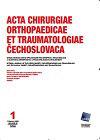髋关节发育不良的后内侧有限手术的功能和放射学结果。
IF 0.4
4区 医学
Q4 ORTHOPEDICS
Acta chirurgiae orthopaedicae et traumatologiae Cechoslovaca
Pub Date : 2023-02-15
DOI:10.55095/achot2023/002
引用次数: 0
摘要
研究目的在髋关节发育不良的治疗算法中,后内侧有限手术介于闭合复位和内侧开放关节复位之间。本研究的目的是评估这种方法的功能和放射学结果。材料和方法这项回顾性研究对30名患者的37例Tönnis II级和III级髋关节发育不良进行了研究。手术时患者的平均年龄为12.4个月。平均随访时间24.5个月。当闭合技术不能实现足够稳定的同心复位时,应用后内侧有限手术。术前未进行牵引。术后,采用人位髋关节骨石膏固定3个月。根据改良McKay功能结果、髋臼指数和是否存在髋臼发育不良或缺血性坏死对结果进行评估。结果36髋髋关节功能满意,1髋关节功能不良。术前髋臼指数平均为34.5度。术后6个月和最后一次对照X光检查时分别提高到27.7和23.1度。髋臼指数的变化具有统计学意义(p<0.05)。在最后一次对照中,3髋出现髋臼残余发育不良,2髋出现缺血性坏死。结论当闭合复位仍然不足,内侧开放式关节复位仍然具有不必要的侵入性时,适用于髋关节发育不良的内侧有限手术。本研究与文献一致,证明该方法可以降低残余髋臼发育不良和股骨头缺血性坏死的发生率。关键词:发育性髋关节发育不良,后内侧有限手术,闭合复位,内侧开放复位。本文章由计算机程序翻译,如有差异,请以英文原文为准。
Functional and Radiologic Results of Posteromedial Limited Surgery in Developmental Dysplasia of the Hip.
PURPOSE OF THE STUDY In treatment algorithm of developmental dysplasia of the hip, posteromedial limited surgery is placed between closed reduction and medial open articular reduction. The aim of the present study was to assess the functional and radiologic results of this method. MATERIAL AND METHODS This retrospective study was performed in 37 Tönnis grade II and III dysplastic hips of 30 patients. The mean age of the patients at operation was 12.4 months. The mean follow-up time was 24.5 months. Posteromedial limited surgery was applied when sufficient stable concentric reduction was not achieved by closed technique. No pre-operative traction was applied. Postoperatively, human position hip spica cast was applied for 3 months. Outcomes were evaluated regarding modified McKay functional results, acetabular index and presences of residual acetabular dysplasia or avascular necrosis. RESULTS Thirty-six hips had satisfactory and one hip had poor functional result. The mean pre-operative acetabular index was 34.5 degrees. It improved to 27.7 and 23.1 degrees at the postoperative 6th month and the last control X-Rays. The change in acetabular index was statistically significant (p<0.05). At the last control, 3 hips had findings of residual acetabular dysplasia and 2 hips had avascular necrosis. CONCLUSIONS Posteromedial limited surgery for developmental dysplasia of the hip is indicated when closed reduction remains insufficient and medial open articular reduction remains unnecessarily invasive. This study, in line with the literature, provides evidences that this method might decrease the incidences of residual acetabular dysplasia and avascular necrosis of the femoral head. Key words: developmental dysplasia of the hip, posteromedial limited surgery, closed reduction, medial open reduction.
求助全文
通过发布文献求助,成功后即可免费获取论文全文。
去求助
来源期刊
CiteScore
0.70
自引率
25.00%
发文量
53
期刊介绍:
Editorial Board accepts for publication articles, reports from congresses, fellowships, book reviews, reports concerning activities of orthopaedic and other relating specialised societies, reports on anniversaries of outstanding personalities in orthopaedics and announcements of congresses and symposia being prepared. Articles include original papers, case reports and current concepts reviews and recently also instructional lectures.

 求助内容:
求助内容: 应助结果提醒方式:
应助结果提醒方式:


